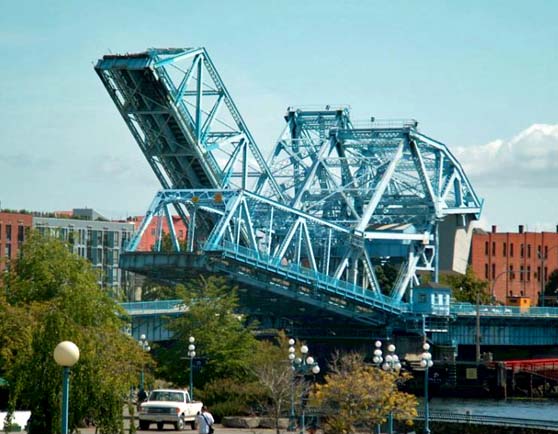
15 August 2010
Ninety Years Later Another Bridge Vote

The Johnson Street Blue Bridge.

Victoria Vancouver Island British Columbia - If only Victoria Mayor Dean Fortin had a time
machine, he could read words like this:
"By a landslide majority, probably the biggest ever rolled up in favour of an important bylaw in Victoria, the Johnson Street Bridge was endorsed at the
polls yesterday."
That's the first paragraph of a story on the front page of the Daily Colonist of 16 Jan 1920, the day after the voters of Victoria gave the green light to the
crossing we call the Blue Bridge.
In 1920, the new $720,000 bridge would replace a 30-year-old swing bridge that had carried only trains and, I'm sure, the occasional pedestrian.
It was seen as a major factor in the expansion of Victoria, because finally the land right across the water from downtown, the land that the government had
bought from the Songhees a few years earlier, could be put to industrial use.
The count was not even close. Voting for the bridge were 2,984 people, while 443 were opposed. Six to one, in other words.
Sure, there had been a few naysayers, people such as former mayor Albert E. Todd, who tried to stop the project. But they were no match for the people who
wanted to see a road crossing between downtown and Vic West.
"The passage of the Johnson Street Bridge bylaw removed the last obstacle in the way of the industrial development of the former Songhees Reserve
area," Premier (Honest) John Oliver said. He added that the province had already spent almost $1 million on the property so it could be made available to
industrial establishments.
Oliver called the plebiscite a "sweeping victory" and a "just verdict."
Agriculture Minister Simon Fraser Tolmie, who would become premier when Oliver died in 1928, said that the successful vote would be "a message to all of
Canada that Victoria is wide awake to her opportunities and intends to make the most of them."
The vote came about after extended negotiations between the city, the province, and the Esquimalt & Nanaimo Railway. The E&N agreed to contribute
$100,000 to the project, and would cover one-third of the operating costs. The province chipped in another $200,000, leaving the city to borrow $420,000 to
complete the work.
Not all of the details had been locked down. The deal called for a single bridge, to be shared by the railway, vehicle traffic, and pedestrians, although I
would guess that cyclists also braved the crossing even back then. In any event, we ended up with two bridges, side by side, not one.
The deal also allowed for the bascule pier to be moved to the west side of the channel from the east. That never happened.
The agreement dealt with financial matters and the operation of the bridge, such as, it was not to be opened within 20 minutes before or after the scheduled
arrival of a train.
The city launched an intensive sales pitch in the first two weeks of 1920.
"The structure is badly needed and the rejection of the scheme would be a retrograde step, injurious to the city's best interests," the Victoria
Daily Times said in an editorial. "Every ratepayer alive to the city's industrial needs should vote for the bylaw on Thursday."
The Daily Colonist didn't argue.
"No development undertaken by the municipality is more likely to lead to immediate and continuous employment than the building of the bridge, for the
results will be cumulative and will continue to ensure when the transportation facility is an accomplished fact," it said.
"Unless opportunities are seized in the lives of individuals and communities, the latter have no one to blame but themselves."
It was an investment, the Colonist said, that would repay the citizens 10-fold before many years had passed.
And so the project was approved, Joseph Baermann Strauss was hired to design yet another of his bascule bridges, and the rest is history.
In 2010, as we consider what to do about the bridge, replace it, or hope for the best, we should not expect the voters to make as convincing a decision as they
made in 1920, even though both sides will tell us that there is really only one sensible choice.
One thing hasn't changed, though: A reliable crossing at the foot of Johnson is vital to our city and our region.
Dave Obee.

|